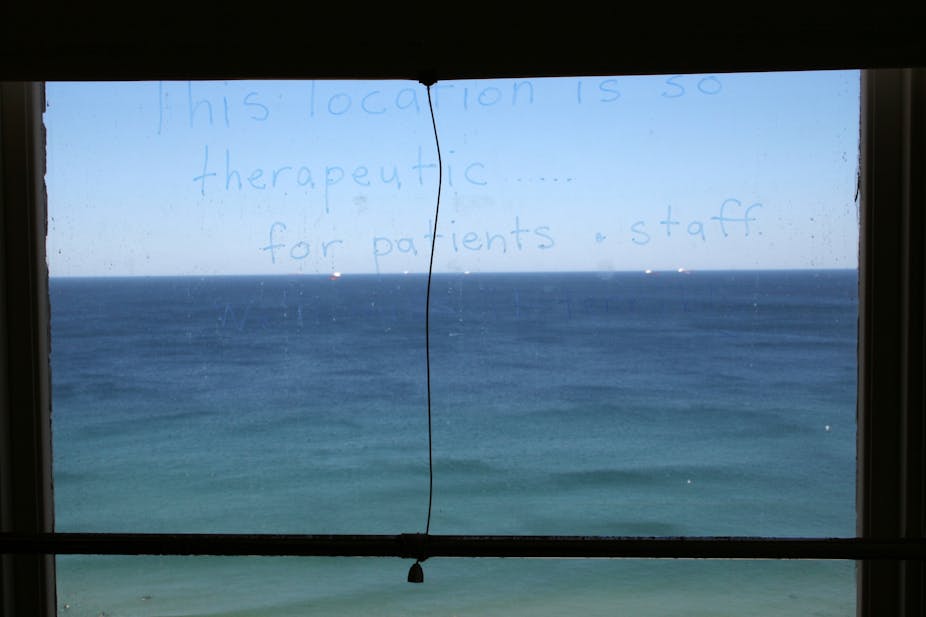Florence Nightingale was a practical, highly experienced nurse who advocated the role of beauty, aesthetics and nature in medical practice. She believed buildings with windows, beautiful views, central courtyards and light were imperative for the healing process.
Nightingale’s insights resonate with current research initiatives associated with the burgeoning field of Arts Health – which links health communities and artists for mutual benefit. In November, federal health minister Peter Dutton endorsed a National Arts and Health framework to support a coordinated approach to arts and health.
The new framework advocates collaborative partnerships between sectors and between the state and federal health systems – in the name of better outcomes for patients and health workers.
There’s a growing body of evidence that shows it’s good for patients and health workers to engage with the arts. What’s more, it provides artists with opportunities to exhibit, perform and engage in activities that promote inclusion, wellbeing and enriched lives.
What is Arts Health?
In Australia Arts Health has produced some significant outcomes for both patients and hospital staff and is at the cutting edge of interdisciplinary research. It combines insights from the visual arts, creative writing, design, architecture, medicine and alternative therapies – and its reach extends to hospitals, schools, aged-care facilities and clinics.
The US project Cirque De-Stress is a great example of what an Arts Health approach can achieve: it promotes stress reduction and mental health awareness through circus practice. In another US initiative, the Alzheimer’s Poetry Project, Alzheimer’s patients are read poems from their childhood. The UK-based Music for Health and Wellbeing project is self-explanatory – and there are thousands of other health-inducing, life-affirming initiatives thriving around the world.
Evidence-based scientific studies have shown the benefits of Arts Health practice in job satisfaction among healthcare professionals, shorter hospital time for patients and improved facets of behaviour, including mental health, among residents of health care communities.
An innovative, flexible and varied field, Arts Health is a perfect medium through which to explore the multifaceted needs of the healthcare environment.
Why the view out the window matters
Over the last two decades, practitioners working in Australia have explored new terrain in Arts Health.
Miranda Lawry, co-author of this article, has spent extensive periods as an artist-in-residence at Newcastle hospitals. She is a photographic artist interested in the work of Swedish healthcare design researcher Roger S. Ulrich, particularly his work on biophilia, that is, the health benefits of environments rich in natural views.
Following Ulrich, Lawry’s art has addressed the healing properties of the hospital window. New hospital buildings require specialist architecture, lighting and ventilation to house new technologies – but not necessarily many extensive or expansive windows.
From 2000 to 2003 Lawry was part of an Arts Health team that investigated new options providing patients and staff with views at Newcastle’s John Hunter Hospital. This was part of a larger project titled Vulnerable Bodies: Art, Architecture and the Public Body in a Hospital Environment.

The team explored research on healthcare environments that provide positive visual distractions as a means of promoting wellness by reducing stress. The result, the “Sky Window” project, involved fitting corridor windows at the hospital with custom-made light boxes into which abstracted landscape images were placed.
The team worked with Dr Paul Thomas, then the Head of Nuclear Medicine at the hospital, and a gifted amateur photographer. Thomas’ scenes formed the basis of the window images, demonstrating a symbiotic, highly engaged collaborative process between medical practitioner and artist.
Such projects challenge and replace the mundane, chocolate-box images that have traditionally been placed on the walls of hospital waiting rooms and corridors.
Lawry was also involved in the Moving the Royal, Framing the Memories project when the Royal Newcastle Hospital was closed in 2006.
This addressed the response of staff to the closure of the iconic, beach-side hospital.
Inspired again by the healing properties of windows, Lawry asked staff to identify their favourite views, then photographed them for an installation in a prominent “memorial” space at the John Hunter Hospital – the site to which staff were transferred.
Staff were actively involved in this collaborative process, and endorsed the benefits of the project, including its role in assisting them to navigate change, to deal with loss, and to face their work-based futures with a sense of ownership.

Arts health is thriving in Australia
In Australia, a leader internationally, Arts Health has a promising future and there are many organisations devoted to promoting its ideas.
The Institute for Creative Healthis a not-for-profit organisation that was established in 2006 as the Arts for Health Foundation. This body’s primary goal is to establish long-term support for Arts Health advocacy, research and practice paradigms across health areas in general and to embed the arts in our approaches to health and wellbeing.
Likewise, Arts and Health Australia – an advocacy organisation dedicated to improving health through artistic engagement – held its sixth annual conference in Sydney on November 12-14.
Experts from all over the world – including medical researchers, medical, nursing and allied health professionals, art therapists, educators, policy-makers and artists – gathered to discuss best practice in arts and health.
The success of the conference went a long way to confirm the significance and robust future of Arts Health both in Australia and worldwide.

